30 Nov 2020
Belkin x CRWR: Soundings
In response to Soundings: An Exhibition in Five Parts, a group of UBC Creative Writing graduate students made a series of activities for visitors to take part in during their visits to the gallery. Thinking through the idea of a score as a call to respond, these activities range from sound walks to reflective worksheets to small group workshops.
Guidance for these activities emerged from tours and workshops with Sheryda Warrener (Lecturer in Creative Writing at UBC), Jay Pahre (Belkin Public Programs and Score Project Coordination) and Naomi Sawada (Belkin Public Programs), but the activities are the creative generation of the students.
A number of these activities and prompts can be viewed on Instagram at @belkinxcrwr. The list of activities and responses are below.
Drift; Pattern; Expand; Embody; Trace; Accompany with Emma Cleary
Curtain; Beading; Chanting Borderlands with Sonia Di Placido
Pattern (Audio Tour); Pattern (Beads) with A.N. Higgins
“I don’t know how to say this,” “What did you experience today,” “Does this exhibit make you question,” with Casey Letendre
Are you here? You are hear. (Workshop) with Logaine Novascues
Soundings Bingo with Clara Otto
Soundings Sound Walk (Portals; Positions; Words) with Jaz Papadoupolos
Scoring the Soundings with Owen Schaefer
Curtain; Beading; Chanting Borderlands with Sonia Di Placido
These are a series of poetic responses to works in Soundings which take the form of audio recordings and written pieces. Please find the recordings and transcriptions below.
These are a series of poetic responses to works in Soundings which take the form of audio recordings and written pieces. Please find the recordings and transcriptions below.
Curtain is a response to Maggie Groat’s arrangements for rotations – rotations for collections – collections for sounds – sounds for light – light for transformations – transformations for arrangements – using only found materials of significance create an /object – collection – tool/ to / mark > absorb > reflect > refract > witness > carry > light + sound of your surroundings – between the shortest day and the longest night + the day that is equal to the night – between the day that is equal to the night + the longest day and the shortest night – between the longest day and the shortest night + the day that is equal to the night – between the day that is equal to the night +the shortest day and the longest night
Skin of A Curtain Belkin Soundwalk
Beading is a response to Olivia Whetung’s Strata
Chanting Borderlands is a response to Tania Willard’s Surrounded/Surrounding
You Are, Hear with Logaine Navascues
This is a handout and transcription that invites you to think about your own experience of Soundings through mapping your body’s course through and responses to the exhibition.
This is a handout and transcription that invites you to think about your own experience of Soundings through mapping your body’s course through and responses to the exhibition.
While you walk. While you slow down. While you stare. While you notice your surroundings. While you read. While you think. While you stay. What do you hear?
This blank space is your own gallery. Use it to write words or draw images that relate to what you think, feel and discover with your senses. The things that resonate and inspire you. And the ones that don’t. Draw connections –and conclusions–. Trace your own path. This is the map of your journey. You are, hear.
Where did you hear each artwork? Write down the words that define your experience where you think they belong. Thoughts, ideas, questions, emotions, feelings, actions, reactions, sensations, perceptions… Is this how you embody your experience? Is this a map of your journey? Are you here?
How was your journey? Choose a path, or trace your own.
Guided Art Walk with jaz papadopoulos
This is a short, guided sound walk through Soundings. Please find audio tracks below; a written transcription follows.
This is a short, guided sound walk through Soundings. Please find audio tracks below; a written transcription follows.
Track 1: Introduction
This is a short, guided sound walk through the Belkin’s Soundings exhibition. There are three prompts, recorded as distinct tracks: Portals, Words, and Positions. While considering the prompts, please move through the exhibit as you wish. Begin by wandering for a few minutes to familiarize yourself with the pieces and then start the next track when you feel oriented and ready to have your attention guided.
Track 2: Portals
Look for portals in the artwork—doorways, windows, halls, passages. Consider where your body is in relation to each portal—where does it compel you to be? In front of it? Behind it? Can you move around it? Consider other places you encounter portals in the world––your home, this gallery, outside. What does a portal look like? What does it sound like? How does it feel to be invited into something? How does it feel to be declined entry? Does a portal differ from a border? Return your attention to the artwork. Ask yourself whether you are invited into this portal or not. Act accordingly.
Track 3: Words
When you see words in the artwork, resist the urge to read them left to right. Instead, try reading them in any other order. How many variations are there? Feel free to do this on paper and make a found poem if you wish! If you are able, say the words out loud. Where do the sounds vibrate in your body? Now try saying the words by only saying the vowels. Where do the sounds vibrate in your body? Now try saying the words by only saying the consonants. Where do the sounds vibrate in your body? Feel how you are the instrument, the words are the musician, and the artist is the conductor.
Track 4: Positions
If you are standing, find somewhere to sit. Notice how the seat bends to receive you (or, not). What can you see or sense from your new position? Repeat this exercise, finding another place to sit, and then another. What can you see now, that you couldn’t see before? What has been lost? With each shift, consider how your perspective changes.
Track 5: Wrap Up
Choose one of these three prompts–Portals, Words or Positions–and continue asking yourself those questions during your commute home, for the rest of your day, or for the rest of your week. See how the world around you is its own type of art!
Scoring the Soundings with Owen Schaefer
This is a handout which invites you to respond to artworks in Soundings through making a score of their own. Please find the handout and a written transcription below.
This is a handout which invites you to respond to artworks in Soundings through making a score of their own. Scoring the Soundings
1. For each artwork you visit, choose a note from the left. Whole notes are the longest. Eighth notes are the shortest. Don’t overthink it. Just go with your gut.
2. There are five symbols to the left of the staff: air, water, fire, wood, and stone. Choose one based on your impression of the artwork. Again, it is an entirely personal choice based on any aspect of the work.
3. Place your note on the line you have chosen. You can put it directly on the line, or in the space above or below the line.
4. Admire your completed score. This is the music of your individual impression of the exhibition. Your own melody of listening and looking.
Creating music from a score is an interpretive process. If you would like to hear a simplified version of your melody, take a picture of the completed score and mail it to soundings@nocentre.com In a day or two, you will be sent a private Dropbox link to a sound-file of your melody. Consider the words you thought about while creating it. You could try to use these to write one or two lines of song-lyric or poetry related to your thoughts on the exhibition. It could be an impression of your feelings, what you saw, or a personal memory it brought to mind. Have fun with it.
Photo (above): Rachel Topham Photography
Related
-
Exhibition
8 Sep – 6 Dec 2020
Soundings: An Exhibition in Five Parts
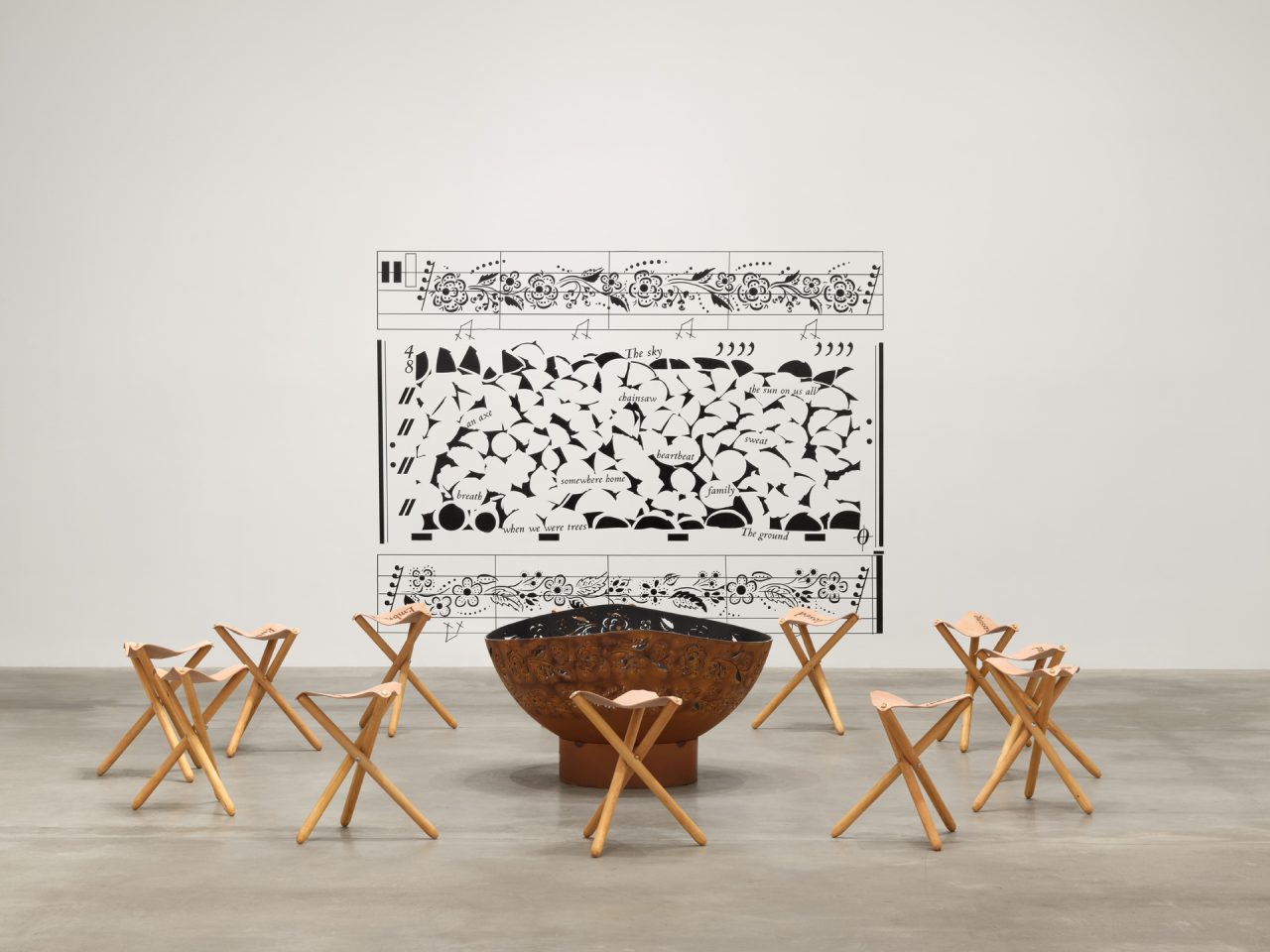
Soundings: An Exhibition in Five Parts features newly commissioned scores, performances, videos, sculptures and sound by Indigenous and other artists who respond to the question, How can a score be a call and tool for decolonization? Unfolding in a sequence of five parts, the scores take the form of beadwork, videos, objects, graphic notation, historical belongings and written instructions. During the exhibition, these scores are activated at specific moments by musicians, dancers, performers and members of the public, gradually filling the gallery and surrounding public spaces with sound and action. Curated by Candice Hopkins and Dylan Robinson, Soundings is cumulative, limning an ever-changing community of artworks, shared experience and engagement. Shifting and evolving, it gains new artists and players in each location. For this iteration on Musqueam territory, the Belkin has collaborated with UBC's Musqueam Language Program in partnership with the Musqueam Indian Band Language and Culture Department; School of Music; Chan Centre for Performing Arts; First Nations House of Learning and Museum of Anthropology to support the production of new artworks and performances by local artists.
[more] -
News
31 Aug 2020
Soundings: Reading Room
The following is a list of resources related to Soundings: An Exhibition in Five Parts. The list of resources compiled here is not an official recommendation, but is rather a list of suggested readings compiled by Public Programs and graduate student researchers at the Belkin Art Gallery. These readings are intended to provide additional context for the exhibition and act as springboards for further research or questions stemming from the exhibition, artists, and works involved.
[more] -
News
10 Dec 2020
Soundings: Marking Time
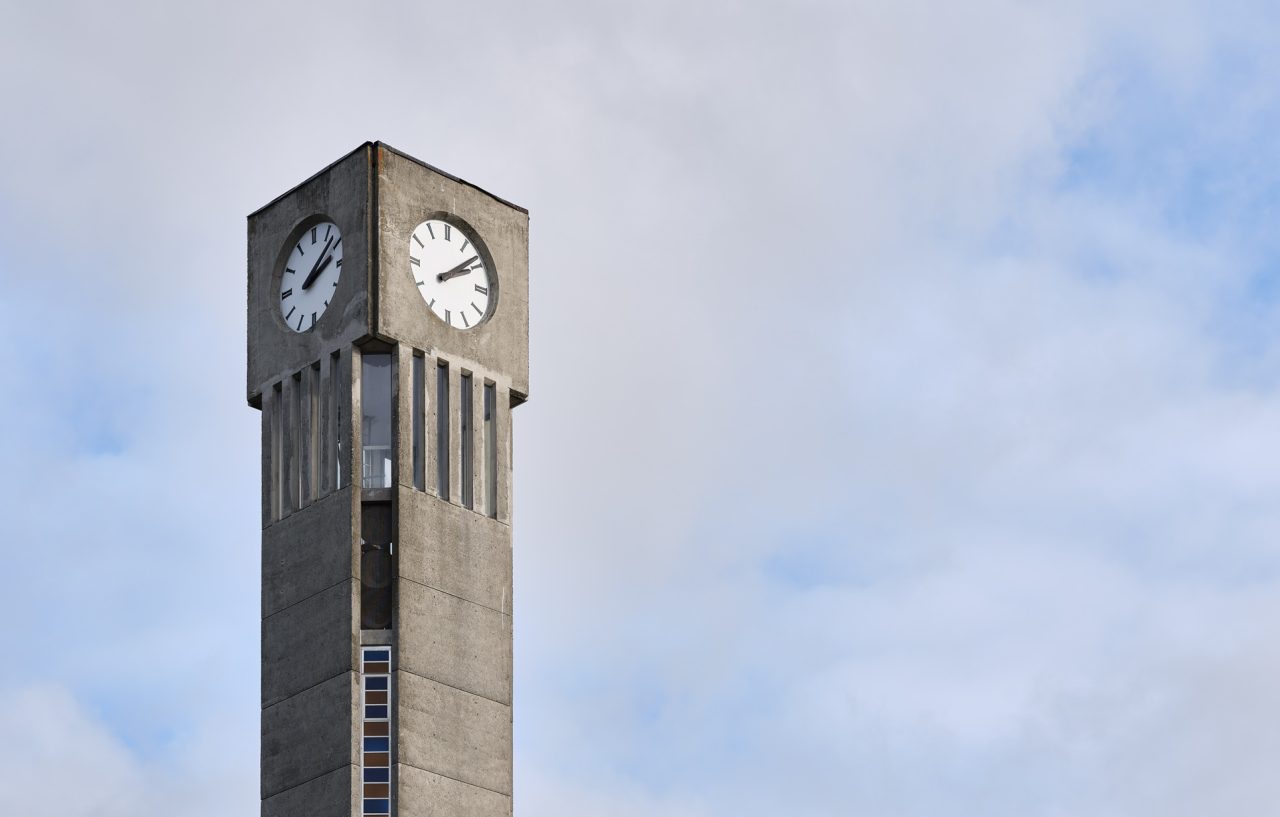 [more]
[more] -
Event
Sunday 8 Nov 2020 at 3 pm
Soundings: Camille Georgeson-Usher and Rachel Kiyo Iwaasa
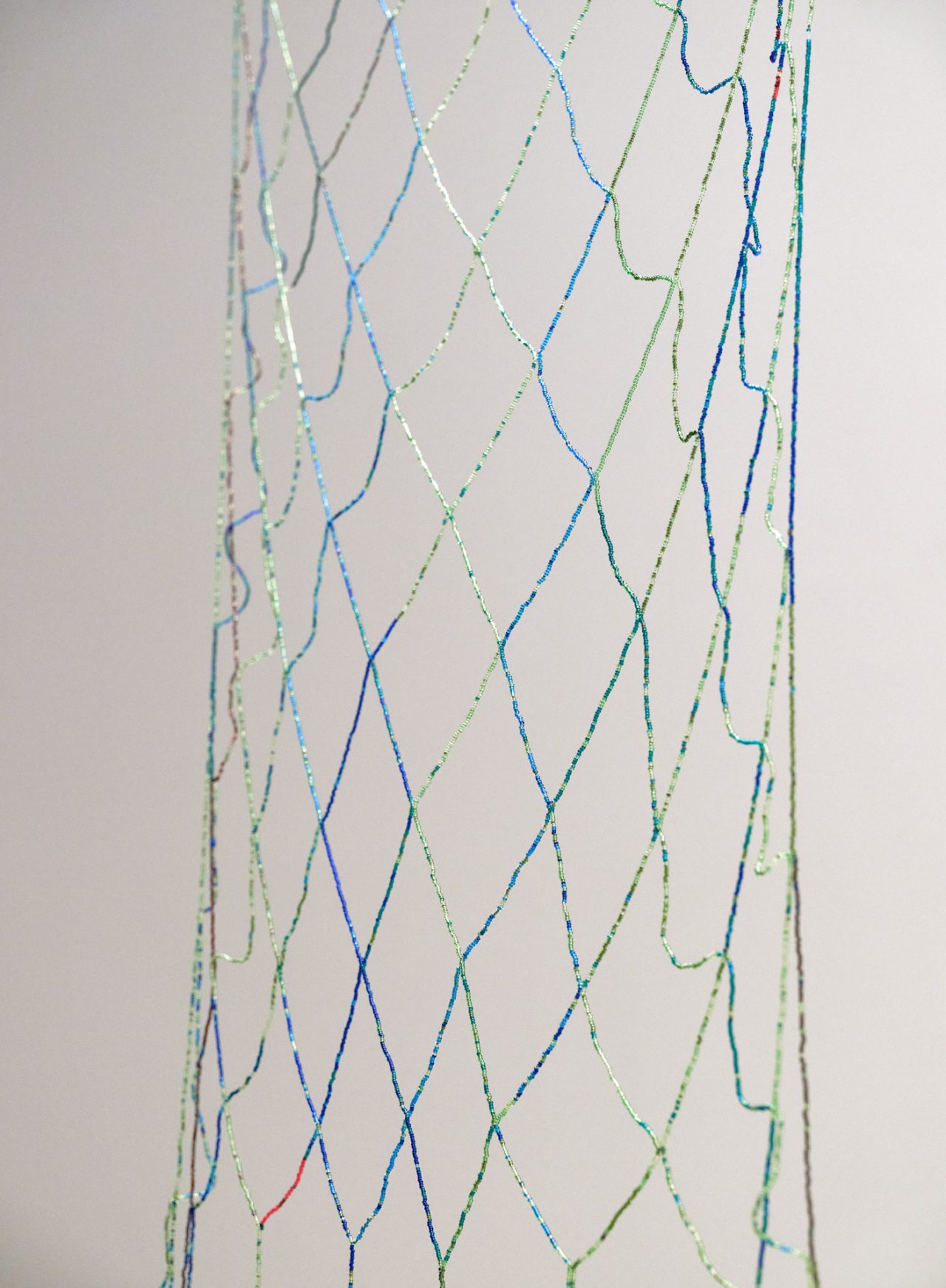
through, in between oceans part 2 by Camille Georgeson-Usher is a beaded installation, completed during the isolation of the Spring 2020 pandemic. The artist worked from home in Toronto, a departure from her intention to spend several months on Galiano Island, BC, where she was raised.
[more] -
Event
10 Sep 2020
Soundings: Diamond Point and Coastal Wolf Pack
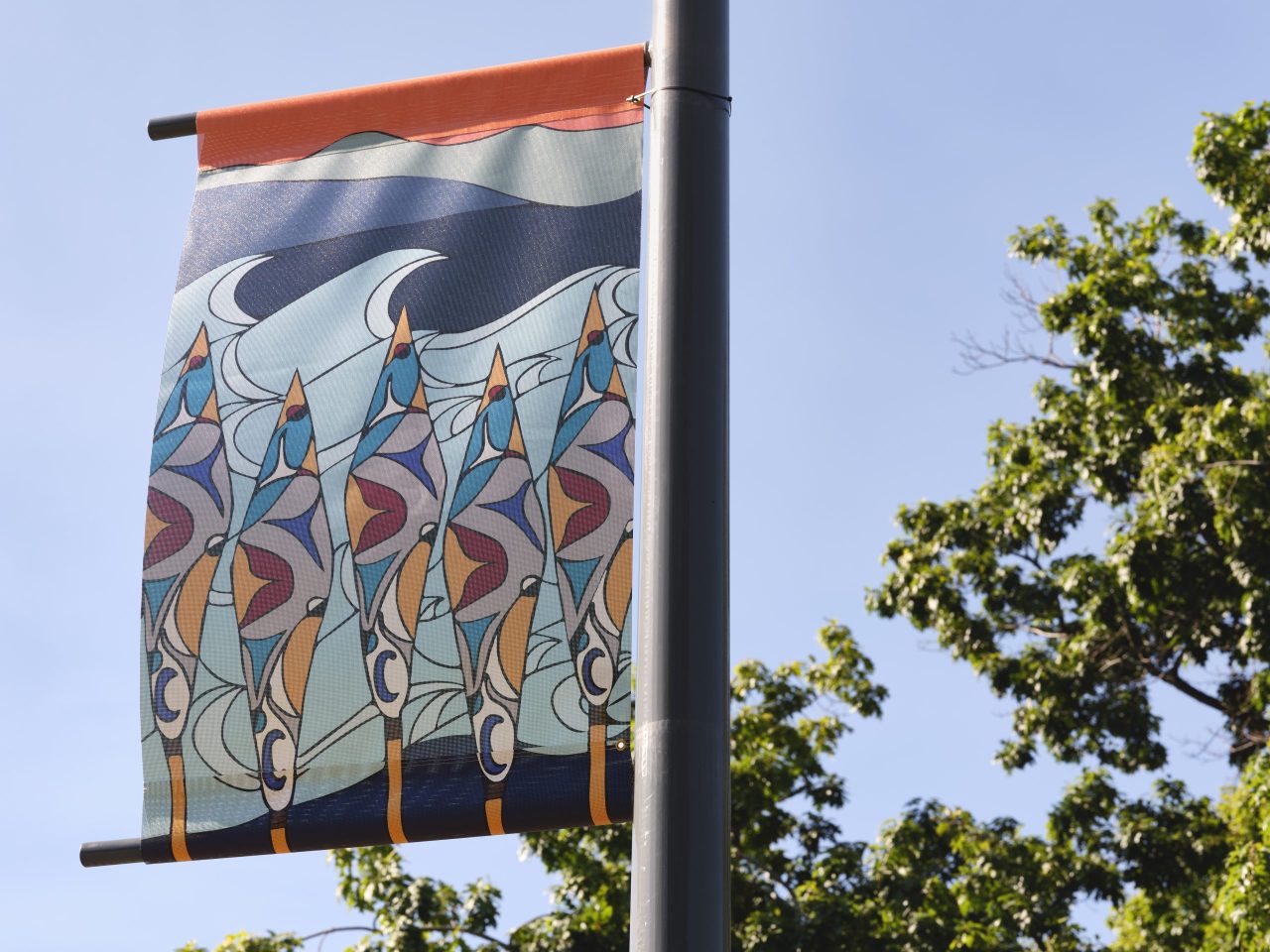
Forming two continuous lines on this part of the traditional, ancestral and unceded territory of the xʷməθkʷəy̓əm (Musqueam) people, wəɬ m̓i ct q̓pəθət tə ɬniməɬ by Diamond Point presents two images repeating in a sequence hung on the lampposts along UBC’s Main Mall from James Hart’s Reconciliation Pole to the plaza just beyond the Belkin.
[more] -
Event
Soundings: Germaine Koh
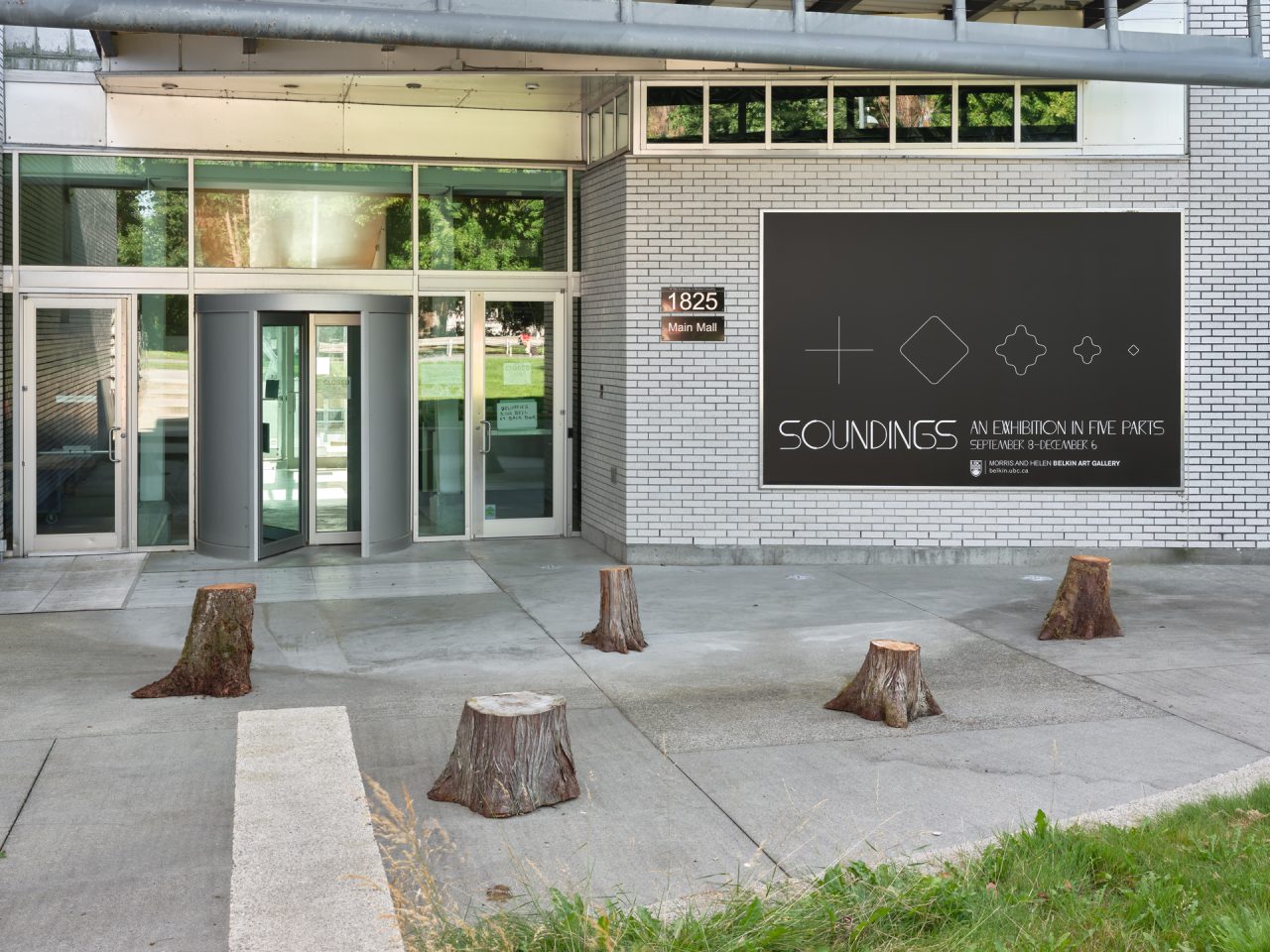
Germaine Koh’s drum is made from one of the cedar tree stumps she first brought to site for use as physical distancing stations. She worked with Belkin staff during Summer 2020 to develop COVID-19 safety and visitor interaction protocols that recognized the importance of collective care and teamwork.
[more] -
Event
8 Sep 2020
Soundings: Greg Staats
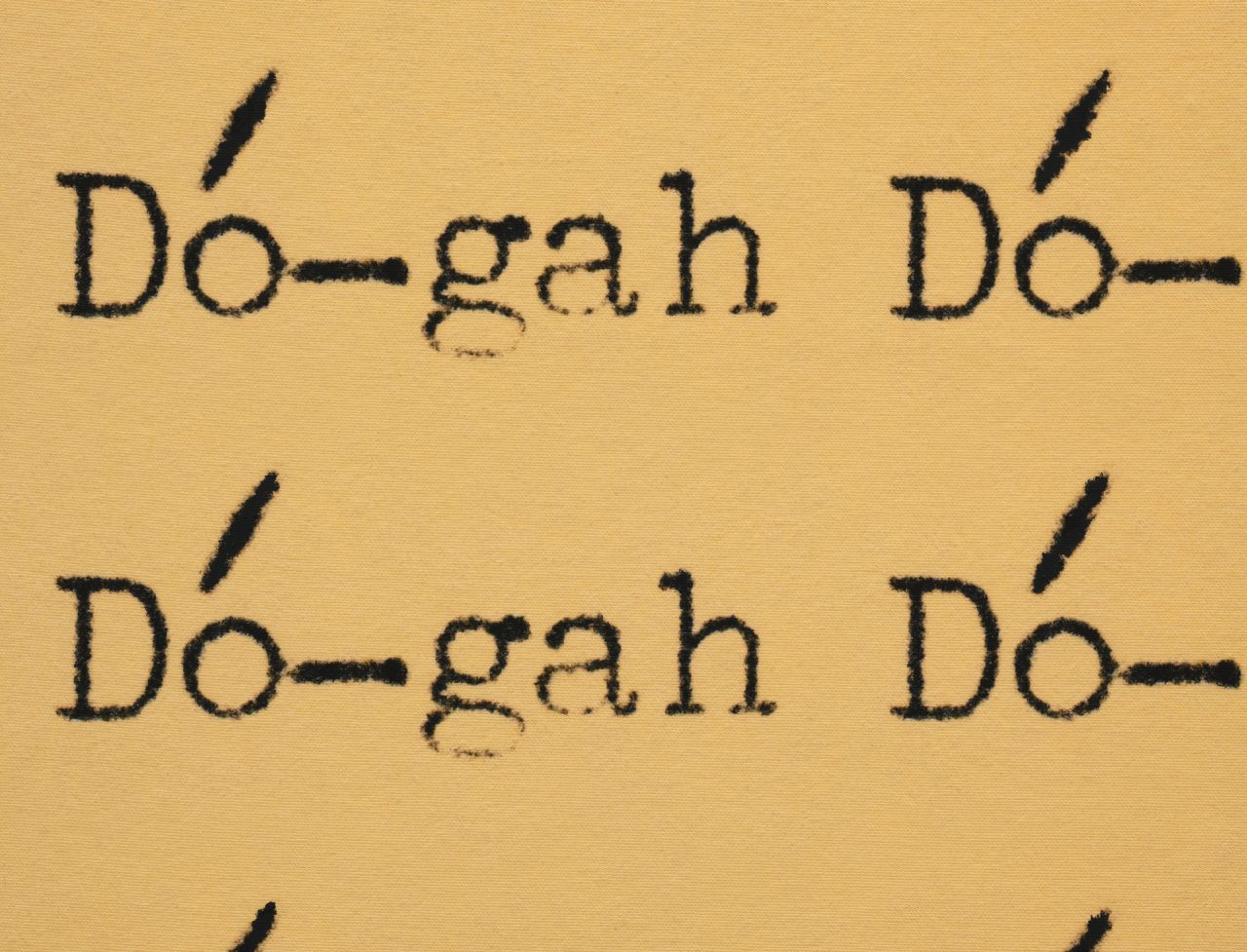 [more]
[more] -
Event
Wednesday 21 Oct 2020 at 3 pm
Wednesday 28 Oct 2020 at 3 pm
Wednesday 25 Nov 2020 at 2 pm
Wednesday 2 Dec 2020 at 3 pm
Sunday 6 Dec 2020 at 3 pm
Soundings: Olivia Whetung and the Ladner Clock Tower Carillon
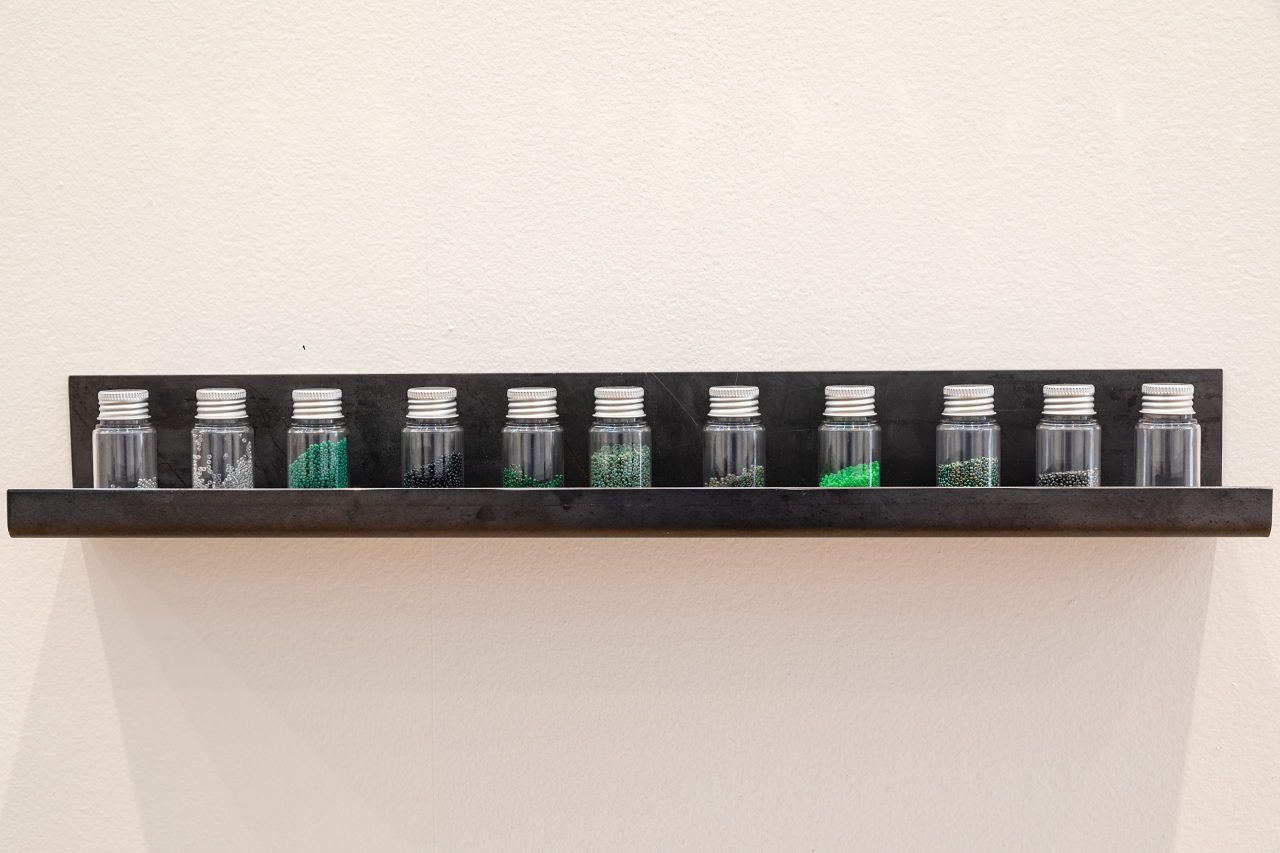
Whetung invites gallery visitors to pour different coloured beads from individual small jars into one large vessel, creating a layering of sounds as each bead joins the growing pile. Once the container is filled, the artist turns the amalgam of beads into an entirely new piece – a rectangular beadwork unique to the Belkin’s iteration of the exhibition.
[more] -
Event
8 Sep 2020
Soundings: Peter Morin and Parmela Attariwala
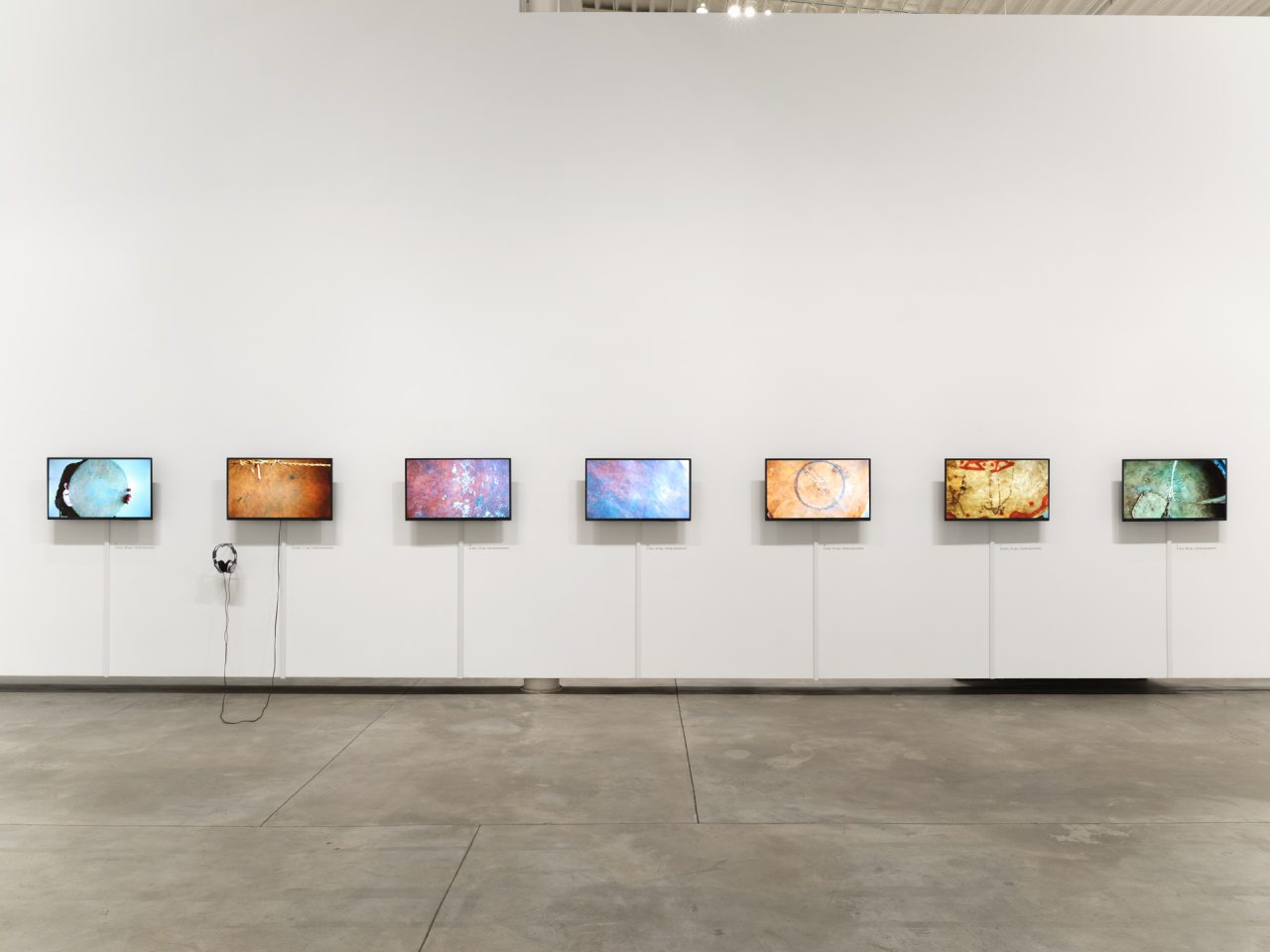
In Part One of NDN Love Songs, Peter Morin offers a score of instructions to musicians presented alongside seven video portraits. Part Two presents videos of recordings of previous iterations of the Soundings exhibition at Agnes Etherington Art Centre, Gund Gallery and Kitchener-Waterloo Art Gallery. In Part Three, Parmela Attariwala performs the score on the violin at the Belkin.
[more] -
Event
8 Oct 2020 at 4 pm
Soundings: Raven Chacon and Symphonic Wind Ensemble
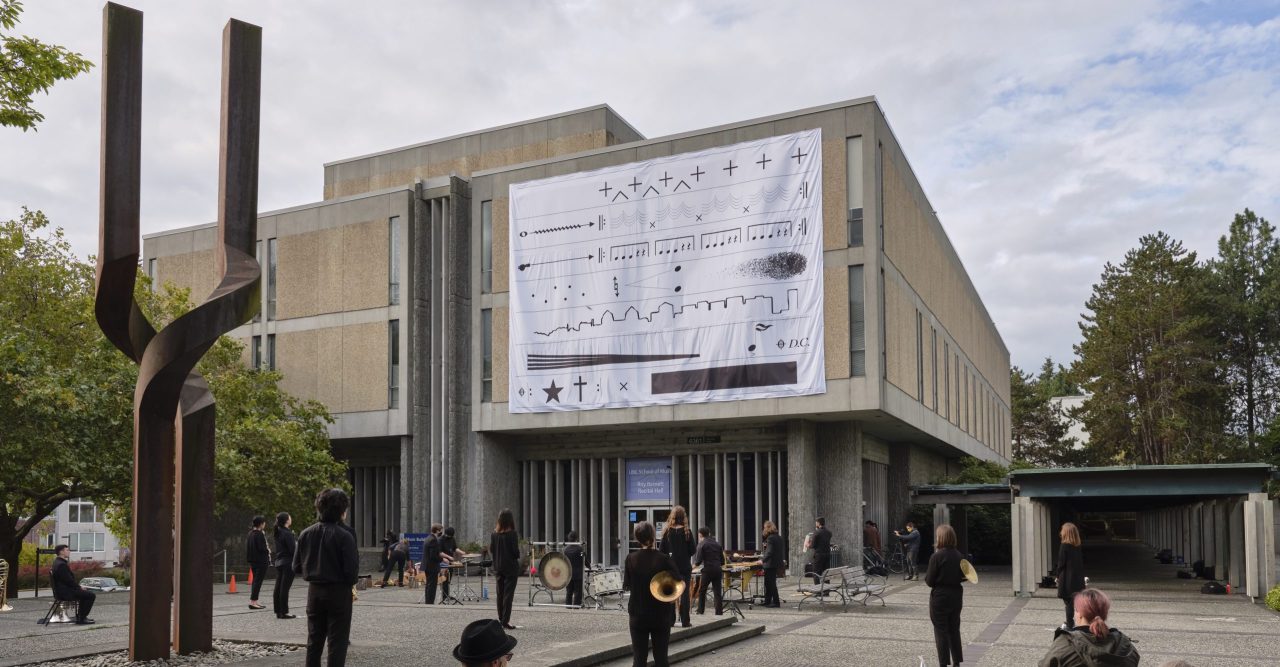
Around the corner from the Belkin Gallery, Raven Chacon's score American Ledger (No. 1) hangs on the exterior of the Music Building at 6361 Memorial Road, UBC. The score incorporates a traditional musical score with Navajo iconography and is to be performed by "many players with sustaining and percussive instruments, voices, coins, axe and wood, a police whistle and the striking of a match."
[more] -
Event
Monday 30 Nov 2020 at 4:30 pm
Soundings: Tania Willard and Melody Courage

Surrounded/Surrounding includes a wood-burning fire bowl, etched leather camp stools and a life-sized rendering of the artist’s wood pile in a graphic score. Written on the split logs and the spaces between them are references to the breathing, beating labour that creates what a fire needs, as well as the trees, sun, sky and ground that surrounds and creates all else.
[more] -
Event
Dec 2020
Soundings: UBC Contemporary Players Respond
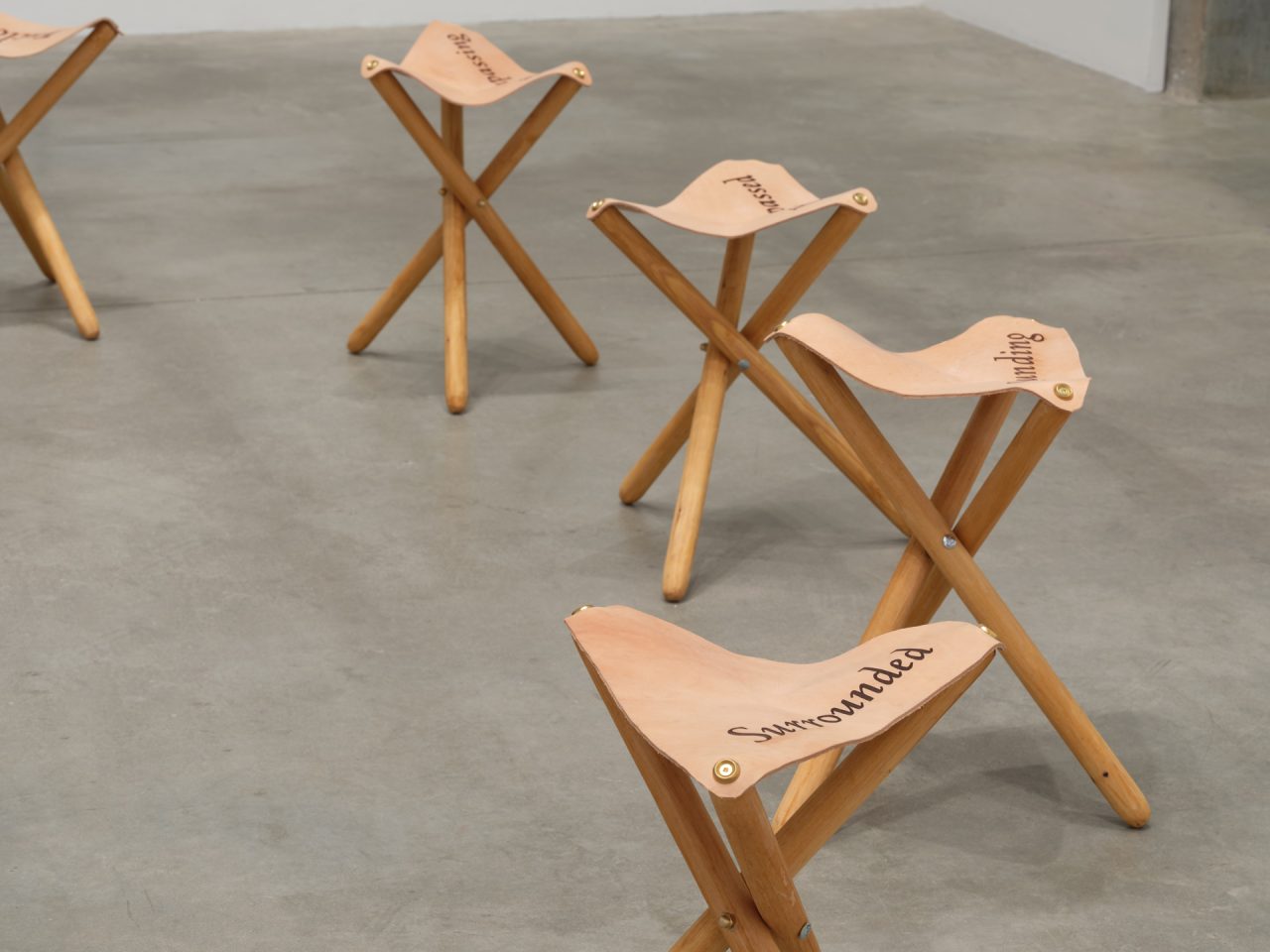
In lieu of a public concert at the Belkin as has occurred in recent years, musicians from UBC Contemporary Players chose a work by a Canadian composer to perform in an empty gallery, responding to the works of Soundings: An Exhibition in Five Parts. Videos of these performances are shared here for reference, research, and enjoyment in perpetuity. Soundings asks how a score can be a call and a tool for decolonization. The exhibition's corresponding investigations take at their centre questions of embodiment and subjectivity, of calls and responses. What are the practical matters of embodied decolonization, and how can we practice them? How does embodiment facilitate unlearning, unknowing, and the visioning of Indigenous ontologies?
[more]